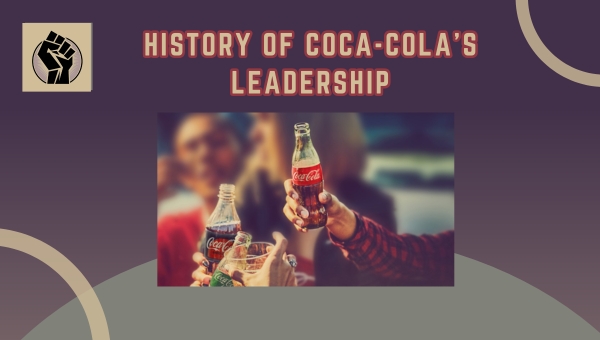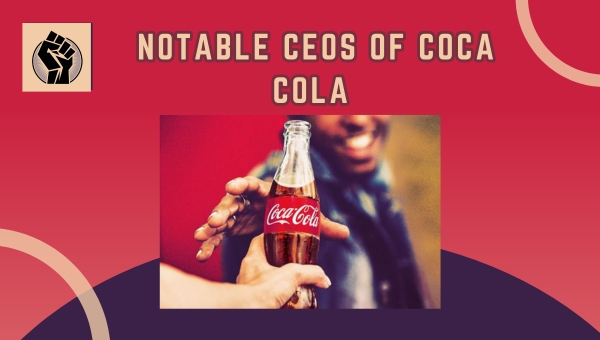Imagine leading one of the world’s most recognized brands, where every decision impacts millions. The story of the CEO of Coca Cola is as fascinating as the company itself, weaving through eras of innovation, challenges, and global expansion. From its humble beginnings to becoming a global giant, Coca Cola’s leadership has played a pivotal role in shaping its success.
This article dives into the strategies, milestones, and influential figures that have steered the brand to its iconic status. If you’re curious about the legacy behind this global powerhouse, keep reading to uncover the leadership secrets of Coca Cola’s enduring success.
History of Coca-Cola’s Leadership
Coca-Cola’s leadership has played a vital role in shaping not only the company but also the global beverage industry. From its early beginnings to becoming a global icon, the leadership journey of Coca-Cola reflects dynamic strategies and adaptability.

Let’s delve into two key eras: the founding years and the period of growth and expansion.
Founding and Early Leadership
The story of Coca-Cola began in 1886 when Dr. John Stith Pemberton, a pharmacist in Atlanta, created the first Coca-Cola syrup.
However, it was Asa Candler, an entrepreneur who purchased the formula in 1888, who laid the foundation for its success. Asa Candler’s leadership was instrumental in transforming Coca-Cola from a local beverage into a household name.
- Strategic Advertising: Candler’s focus on aggressive marketing and branding was unprecedented at the time. He introduced coupons for free samples, ensuring more people tried the product.
- Expansion of Distribution: Under his leadership, Coca-Cola expanded its distribution network, making the drink available in soda fountains across the United States.
- Trademark Registration: Candler ensured Coca-Cola’s trademark was officially registered in 1893, protecting the brand’s identity from competitors.
This early leadership phase set the tone for Coca-Cola’s future growth by building a strong product identity and market presence.
Growth and Expansion Era
As Coca-Cola moved beyond its early years, the company entered a period of rapid growth and global expansion. This phase required visionary leadership to adapt to changing markets and consumer preferences.
- Leadership of Robert Woodruff: One of the most notable figures during this era was Robert Woodruff, who became president of Coca-Cola in 1923. He is credited with making Coca-Cola a global brand.
- Global Market Presence: Woodruff focused on international markets, ensuring Coca-Cola was available in over 44 countries by the 1930s.
- Innovative Packaging: He introduced the six-bottle carton and standardized the iconic contour bottle design, which became a symbol of the brand.
- World War II Strategy: During World War II, Woodruff ensured that American troops had access to Coca-Cola wherever they were stationed. This move not only boosted morale but also introduced Coca-Cola to international audiences, fostering global demand.
- Post-War Leadership: After the war, the company continued to expand under new leaders, focusing on product diversification and regional bottling partnerships to meet growing demand.
This era of leadership highlighted the importance of innovation, strategic foresight, and adaptability in taking Coca-Cola from a national brand to a global powerhouse.
Also Read: Where Was Coca-Cola Invented – Its Fascinating Origins
Notable CEOs of Coca Cola
The Coca-Cola Company, one of the most recognized brands globally, has had a series of influential leaders at its helm. These CEOs of Coca Cola have not only guided the company through various economic landscapes but also left a significant mark on its growth, reputation, and global success.

Each era of leadership reflects unique strategies and challenges, shaping Coca-Cola into the powerhouse it is today. Let’s delve deeper into the remarkable individuals who have taken on the responsibility of leading this iconic company.
1. Asa Candler (1892–1916)
Asa Candler was Coca-Cola’s first CEO and an instrumental figure in its early success. After acquiring the company from its inventor, John Stith Pemberton, Candler turned a small, regional beverage into a national icon.
- Key Achievements:
- Pioneered mass marketing strategies, including coupons and widespread advertising.
- Focused on branding, making the Coca-Cola name synonymous with quality.
- Expanded operations, establishing bottling plants that allowed for wider distribution.
- Under his leadership, the company transitioned from a local business to a national enterprise.
2. Robert Woodruff (1923–1954)
Robert Woodruff is often regarded as one of Coca-Cola’s most transformational CEOs. His tenure spanned over three decades, during which he solidified Coca-Cola as a global brand.
- Key Achievements:
- Introduced innovative marketing techniques, such as associating Coca-Cola with holidays like Christmas.
- Played a pivotal role in Coca-Cola becoming available to U.S. troops during World War II, which expanded its global reach.
- Focused on consistency in taste and quality worldwide.
- Enhanced the company’s infrastructure, including logistics and production facilities.
3. J. Paul Austin (1962–1980)
J. Paul Austin led Coca-Cola during a time of significant cultural and economic shifts. He expanded Coca-Cola’s global reach while adapting to new societal demands.
- Key Achievements:
- Increased the company’s presence in emerging markets, particularly in Africa and Asia.
- Diversified the company’s portfolio through the acquisition of Minute Maid, expanding into fruit juices and other beverages.
- Focused on corporate responsibility, responding to changing consumer expectations.
- Maintained Coca-Cola’s dominance during the rise of competitors, such as Pepsi.
4. Roberto Goizueta (1981–1997)
Roberto Goizueta’s leadership marked a bold shift in Coca-Cola’s strategy. Under his direction, the company experienced unprecedented financial success.
- Key Achievements:
- Increased Coca-Cola’s market value from $4 billion to over $140 billion during his tenure.
- Introduced the controversial “New Coke” formula, which, despite initial backlash, ultimately strengthened consumer loyalty to the original product.
- Focused on aggressive international expansion, making Coca-Cola the most recognized brand globally.
- Emphasized shareholder value, boosting profits and dividends consistently.
5. Douglas Daft (2000–2004)
Douglas Daft’s leadership reflected a shift towards consumer-centric strategies. He responded to the changing marketplace and evolving consumer preferences.
- Key Achievements:
- Implemented a decentralized management approach, giving more autonomy to regional markets.
- Focused on healthier beverage options, introducing products like water and diet sodas.
- Strengthened relationships with bottling partners to improve efficiency.
- Addressed challenges like declining soda sales and increased competition.
6. Muhtar Kent (2009–2017)
Muhtar Kent focused on sustainability and long-term growth during his time as CEO. His leadership emphasized innovation and environmental responsibility.
- Key Achievements:
- Invested heavily in sustainable practices, such as water conservation and eco-friendly packaging.
- Expanded the company’s portfolio to include non-carbonated beverages, such as teas, coffees, and energy drinks.
- Strengthened partnerships with global retailers to improve market penetration.
- Enhanced the company’s digital marketing strategies to connect with younger audiences.
7. James Quincey (2017–Present)
James Quincey, the current CEO of Coca Cola, has brought a renewed focus on innovation and modernization. His approach reflects a blend of tradition and forward-thinking.
- Key Achievements:
- Spearheaded the company’s “Beverages for Life” strategy, diversifying its offerings to cater to a wide range of tastes.
- Emphasized digital transformations within the company, using data analytics to better understand consumer behavior.
- Strengthened Coca-Cola’s commitment to sustainability, aiming for carbon neutrality and greater recycling efforts.
- Navigated challenges like the COVID-19 pandemic, ensuring the company remained resilient and adaptable.
The CEOs of Coca Cola have each contributed uniquely to the company’s evolution. From Asa Candler’s foundational efforts to James Quincey’s innovative strategies, these leaders have collectively ensured Coca-Cola’s position as a leader in the global beverage industry.
Leadership Styles And Their Impact
The leadership styles of the CEOs of Coca-Cola have had a profound influence on the company’s global reach and performance. Each leader brought their unique approach, adapting to the needs of the times and market demands.

Let’s explore how strategic decisions and challenges shaped Coca-Cola’s journey under various leaders.
Strategic Changes And Innovations
Throughout its history, Coca-Cola has seen numerous strategic changes and innovations. These were driven by leaders who sought to enhance the company’s market position and adapt to evolving consumer preferences.
Below are some of the significant shifts made under different leadership approaches:
- Introduction of New Products: Leaders like Roberto Goizueta introduced products like Diet Coke, addressing the demand for low-calorie beverages and expanding Coca-Cola’s product line significantly. This decision remains a pivotal moment in the company’s history.
- Globalization Efforts: During the tenure of leaders such as Douglas Ivester, the company focused on aggressive global expansion, particularly in emerging markets. This helped Coca-Cola establish a strong international footprint.
- Technological Advancements: Leaders like James Quincey have emphasized the use of technology in streamlining operations, like using data analytics to predict consumer behavior and managing supply chains more efficiently.
- Sustainability Initiatives: Recent leadership has prioritized sustainable practices, such as introducing recyclable packaging and reducing water usage, aligning with global environmental concerns.
Challenges And Controversies
Coca-Cola’s leadership has also faced its share of challenges and controversies. Addressing these issues has been critical for maintaining the company’s reputation and operational stability.
Here are some notable instances:
- Formula Change (New Coke): Under Roberto Goizueta, the company faced backlash when it changed its iconic formula in 1985. Consumer dissatisfaction was so intense that Coca-Cola had to revert to the original recipe, now branded as “Coca-Cola Classic.”
- Health Concerns: Leaders have continually grappled with criticism regarding the health impacts of sugary beverages. Strategies such as promoting smaller portion sizes and marketing zero-calorie options have been implemented to address such concerns.
- Environmental Criticism: Coca-Cola has faced allegations of contributing to plastic pollution. Recent leadership has worked toward mitigating this by committing to 100% recyclable packaging and investing in recycling technologies.
- Market Competition: Leadership has navigated intense pressure from competitors like PepsiCo. By introducing innovative marketing campaigns and diversifying the product lineup, Coca-Cola has maintained its competitive edge.
Examining these elements reveals how leadership decisions, both innovative and corrective, have been instrumental in shaping Coca-Cola’s legacy. Each CEO’s approach reflects a balance of ambition and resilience in steering the company through varying market landscapes.
Also Read: Brad’s Drink Pepsi | The Refreshing Revolution
Role Of A CEO In Coca Cola’s Global Success
The CEO of Coca-Cola plays a pivotal role in steering the company toward global success. By making strategic decisions, adapting to market demands, and ensuring the brand remains relevant, the CEO shapes Coca-Cola’s future.
Let’s explore two key areas where this leadership has a significant impact.
Navigating Market Fluctuations
Managing market changes is a critical responsibility for any CEO, especially for a company like Coca-Cola that operates globally.
Here’s how Coca-Cola’s CEOs have tackled these challenges:
- Adapting to Consumer Trends: By understanding shifts in consumer preferences, such as the rising demand for healthier drinks, Coca-Cola’s leaders have introduced low-sugar and non-carbonated beverages.
- Economic Strategy: During periods of economic downturns, CEOs have implemented cost-cutting measures while ensuring product availability remains consistent across markets.
- Global Presence Adjustments: Coca-Cola’s leadership has worked on optimizing operations in emerging and developed markets to handle currency fluctuations and varying regional demands effectively.
- Technological Integration: By leveraging data analytics, CEOs have evaluated market trends to make informed decisions and forecast potential disruptions.
Emphasizing Sustainability
Sustainability has become a cornerstone of Coca-Cola’s strategy, and the CEO’s vision is integral to embedding these practices.
Here’s how leadership has prioritized sustainability:
- Eco-Friendly Packaging: The company has invested in recyclable and reusable materials to reduce environmental impact, showcasing the CEO’s commitment to innovation and responsibility.
- Water Stewardship: Coca-Cola aims to replenish more water than it uses in its production processes, a goal driven by strong leadership efforts.
- Partnership Initiatives: CEOs have collaborated with organizations to promote recycling programs and community welfare projects worldwide.
- Long-Term Goals: Setting ambitious targets, such as achieving net-zero emissions, reflects the company’s forward-thinking leadership.
Each of these elements highlights the CEO’s crucial role in maintaining Coca-Cola’s status as a global leader while addressing contemporary challenges effectively.
FAQs
How old is Coca-Cola?
Coca-Cola was created in 1886, making it over 135 years old. It has grown from a small pharmacy drink to a globally recognized brand.
Who is the owner of Coke?
Coca-Cola is owned by The Coca-Cola Company, a publicly traded corporation. Its ownership is shared among numerous shareholders worldwide.
Who founded the Coca-Cola company?
Coca-Cola was founded by John Stith Pemberton, a pharmacist, in Atlanta, Georgia, in 1886. He developed the original formula for the iconic beverage.
Conclusion
The journey of the CEO of Coca Cola reflects a legacy of innovation, adaptability, and strategic leadership that has shaped the company into a global powerhouse. From its early beginnings to becoming an iconic brand, Coca Cola’s success underscores the importance of visionary leadership and effective decision-making.
Each CEO has played a pivotal role in steering the company through challenges, embracing growth opportunities, and prioritizing sustainability in an ever-changing market.
If you found this article insightful, explore more on my site for detailed discussions on leadership, business strategies, and global success stories. Stay informed and empowered with content that inspires and educates!





